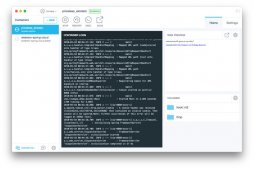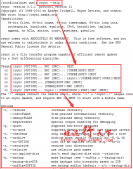我們的網絡管理中心作為管理中心,是服務端!各個被管設備通過交換機作為客戶端與網管中心進行通信,使用的TCP/IP協議!
SNMP只是一種協議包,SNMP4J作為SNMP使用的Java工具包,提供了方便安全的工具包功能!
但是在使用中發現一個問題就是,服務端與客戶端發送消息時,發送數次后就不再發送數據了!網絡抓包也抓不到,跟蹤斷點到SNMP4J的代碼中發現了這樣一個問題!
|
1
2
3
4
5
6
7
8
9
10
11
12
13
14
15
16
17
18
19
|
/** * Sends a SNMP message to the supplied address. * * @param address * an <code>TcpAddress</code>. A * <code>ClassCastException</code> is thrown if * <code>address</code> is not a <code>TcpAddress</code> * instance. * @param message * byte[] the message to sent. * @throws IOException */public void sendMessage(Address address, byte[] message) throws java.io.IOException { if (server == null) { listen(); } serverThread.sendMessage(address, message);} |
我們可以看到,他與UDP的不同是,使用了一個服務的線程!
|
1
2
3
4
5
6
7
8
9
10
11
12
13
14
15
16
17
18
19
20
21
22
23
24
25
26
27
28
29
30
31
32
33
34
35
36
37
38
39
40
41
42
43
44
45
46
47
48
49
50
51
|
public void sendMessage(Address address, byte[] message) throws java.io.IOException { Socket s = null; SocketEntry entry = (SocketEntry) sockets.get(address); if (logger.isDebugEnabled()) { logger.debug("Looking up connection for destination '" + address + "' returned: " + entry); logger.debug(sockets.toString()); } if (entry != null) { s = entry.getSocket(); } if ((s == null) || (s.isClosed()) || (!s.isConnected())) { if (logger.isDebugEnabled()) { logger.debug("Socket for address '" + address + "' is closed, opening it..."); } pending.remove(entry); SocketChannel sc = null; try { // Open the channel, set it to non-blocking, initiate // connect sc = SocketChannel.open(); sc.configureBlocking(false); sc .connect(new InetSocketAddress( ((TcpAddress) address).getInetAddress(), ((TcpAddress) address).getPort())); s = sc.socket(); entry = new SocketEntry((TcpAddress) address, s); entry.addMessage(message); sockets.put(address, entry); synchronized (pending) { pending.add(entry); } selector.wakeup(); logger.debug("Trying to connect to " + address); } catch (IOException iox) { logger.error(iox); throw iox; } } else { entry.addMessage(message); synchronized (pending) { pending.add(entry); } selector.wakeup(); }} |
他從一個Map中去獲得連接 SocketEntry ,然后得到連接對象Socket!
判斷Socket是否有效,有效則直接發送,無效則創建連接后再發送!
然后我找到這樣一段代碼
|
1
2
3
4
5
|
private synchronized void timeoutSocket(SocketEntry entry) { if (connectionTimeout > 0) { socketCleaner.schedule(new SocketTimeout(entry), connectionTimeout); } } |
也就是說服務端會自己檢查的連接并且去清除他!
我嘗試設置 connectionTimeout 的值
|
1
2
3
4
5
6
7
8
9
10
11
12
13
14
15
16
|
private void init() throws UnknownHostException, IOException { threadPool = ThreadPool.create("Trap", 2); dispatcher = new MultiThreadedMessageDispatcher(threadPool,new MessageDispatcherImpl()); // 本地IP與監聽端口 listenAddress = GenericAddress.parse(System.getProperty("snmp4j.listenAddress", "tcp:192.168.9.69/5055")); DefaultTcpTransportMapping transport; transport = new DefaultTcpTransportMapping((TcpAddress) listenAddress); transport.setConnectionTimeout(0); snmp = new Snmp(dispatcher, transport); snmp.getMessageDispatcher().addMessageProcessingModel(new MPv1()); snmp.getMessageDispatcher().addMessageProcessingModel(new MPv2c()); snmp.getMessageDispatcher().addMessageProcessingModel(new MPv3()); USM usm = new USM(SecurityProtocols.getInstance(), new OctetString(MPv3.createLocalEngineID()), 0); SecurityModels.getInstance().addSecurityModel(usm); snmp.listen(); } |
增加一行代碼 設置DefaultTcpTransportMapping的超時時間是 0 !
然后就沒有問題了!
雖然臨時解決了問題,但是由于對SNMP4J不夠深入了解,我怕問題恐怕不是這樣的!
我在此也希望使用SNMP4J為工具,且作為服務端,在發送數據時有問題的解決方法!
以上就是本文的全部內容,希望對大家的學習有所幫助,也希望大家多多支持服務器之家。
原文鏈接:https://www.iteye.com/blog/cuisuqiang-1685183















